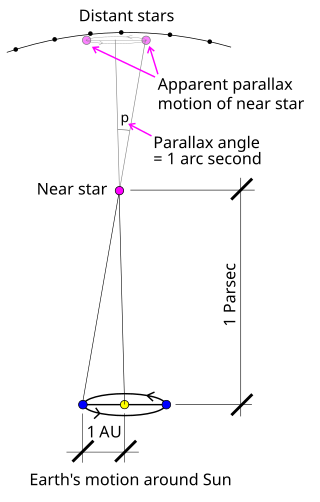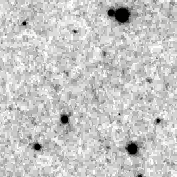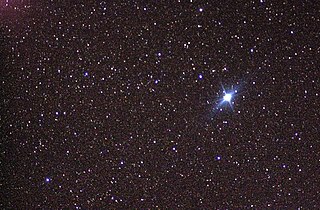Related Research Articles

The astronomical unit is a unit of length, roughly the distance from Earth to the Sun and approximately equal to 150 million kilometres or 8.3 light-minutes. The actual distance from Earth to the Sun varies by about 3% as Earth orbits the Sun, from a maximum (aphelion) to a minimum (perihelion) and back again once each year. The astronomical unit was originally conceived as the average of Earth's aphelion and perihelion; however, since 2012 it has been defined as exactly 149597870700 m.

The parsec is a unit of length used to measure the large distances to astronomical objects outside the Solar System, approximately equal to 3.26 light-years or 206,265 astronomical units (AU), i.e. 30.9 trillion kilometres. The parsec unit is obtained by the use of parallax and trigonometry, and is defined as the distance at which 1 AU subtends an angle of one arcsecond. The nearest star, Proxima Centauri, is about 1.3 parsecs from the Sun. Most stars visible to the naked eye are within a few hundred parsecs of the Sun, with the most distant at a few thousand.

Stellar parallax is the apparent shift of position (parallax) of any nearby star against the background of distant stars. By extension, it is a method for determining the distance to the star through trigonometry, the stellar parallax method. Created by the different orbital positions of Earth, the extremely small observed shift is largest at time intervals of about six months, when Earth arrives at opposite sides of the Sun in its orbit, giving a baseline distance of about two astronomical units between observations. The parallax itself is considered to be half of this maximum, about equivalent to the observational shift that would occur due to the different positions of Earth and the Sun, a baseline of one astronomical unit (AU).

Ross 128 is a red dwarf in the equatorial zodiac constellation of Virgo, near β Virginis. The apparent magnitude of Ross 128 is 11.13, which is too faint to be seen with the unaided eye. Based upon parallax measurements, the distance of this star from Earth is 11.007 light-years, making it the twelfth closest stellar system to the Solar System. It was first cataloged in 1926 by American astronomer Frank Elmore Ross.

Sir Frank Watson Dyson, KBE, FRS, FRSE was an English astronomer and the ninth Astronomer Royal who is remembered today largely for introducing time signals ("pips") from Greenwich, England, and for the role he played in proving Einstein's theory of general relativity.

Thomas Henderson FRSE FRS FRAS was a Scottish astronomer and mathematician noted for being the first person to measure the distance to Alpha Centauri, the major component of the nearest stellar system to Earth, the first to determine the parallax of a fixed star, and for being the first Astronomer Royal for Scotland.

Edward Charles Pickering was an American astronomer and physicist and the older brother of William Henry Pickering. Along with Carl Vogel, Pickering discovered the first spectroscopic binary stars. He wrote Elements of Physical Manipulations.

Sir David Gill was a Scottish astronomer who is known for measuring astronomical distances, for astrophotography and geodesy. He spent much of his career in South Africa.

Robert Thorburn Ayton Innes FRSE FRAS was a British-born South African astronomer best known for discovering Proxima Centauri in 1915, and numerous binary stars. He was also the first astronomer to have seen the Great January Comet of 1910, on 12 January. He was the founding director of a meteorological observatory in Johannesburg, which was later converted to an astronomical observatory and renamed to Union Observatory. He was the first Union Astronomer. Innes House, designed by Herbert Baker, built as his residence at the observatory, today houses the South African Institute of Electrical Engineers.

Grigory Abramovich Shajn was a Soviet/Russian astronomer. In modern English transliteration, his surname would be given as Shayn, but his astronomical discoveries are credited under the name G. Shajn. Nonetheless, his last name is sometimes given as Schayn.

Carl Vilhelm Ludwig Charlier was a Swedish astronomer. His parents were Emmerich Emanuel and Aurora Kristina Charlier.

Van Maanen 2, or van Maanen's Star, is the closest known solitary white dwarf to the solar system. It is a dense, compact stellar remnant no longer generating energy and has equivalent to about 68% of the Sun's mass but only 1% of its radius. At a distance of 14.1 light-years it is the third closest of its type of star after Sirius B and Procyon B, in that order. Discovered in 1917 by Dutch–American astronomer Adriaan van Maanen, Van Maanen 2 was the third white dwarf identified, after 40 Eridani B and Sirius B, and the first solitary example.
Leslie John Comrie FRS was an astronomer and a pioneer in mechanical computation.

Canopus is the brightest star in the southern constellation of Carina and the second-brightest star in the night sky. It is also designated α Carinae, which is Latinised to Alpha Carinae. With a visual apparent magnitude of −0.74, it is outshone only by Sirius.
The Reverend Thomas Henry Espinell Compton Espin or T. H. E. C. Espin was a British astronomer. His father Thomas Espin was Chancellor of the Diocese of Chester and his mother was Elizabeth.
Arthur Robert Hinks, CBE, FRS was a British astronomer and geographer.
Mary Acworth Evershed was a British astronomer and scholar. Her work on Dante Alighieri was written under the pen name M.A. Orr. Although her middle name is increasingly appearing as Ackworth, this is incorrect. She always gave it as Acworth, and it appeared as such in both her obituaries. The one appearing in the Monthly Notices of the Royal Astronomical Society was written by her nephew A. David Thackeray, who presumably would have known. The first appearance of this incorrect version could well have occurred in the proposal of Mary to be a Fellow of the Royal Astronomical Society; the correct spelling appears when she was subsequently elected a Fellow.
Alice Grace Cook (18 February 1877 - 27 May 1958), known as Grace Cook or A. Grace Cook was a British astronomer. Cook lived in Stowmarket, Suffolk. After she died she was remembered by her colleagues as a skilled and dedicated observer. In September 2021 it was announced that a new school in the town was to be named after Grace Cook. The school will be run by the Orwell Multi Academy Trust. In March 2023 minor planet 2000 EY156 was named Gracecook in her honour.
Innes' star is an M3.5-type red dwarf, located in constellation Carina. It has around 35% of the mass of the Sun, yet only 1.1% of its luminosity, and an estimated surface temperature of 3,323 K.

The most important fundamental distance measurements in astronomy come from trigonometric parallax, as applied in the stellar parallax method. As the Earth orbits the Sun, the position of nearby stars will appear to shift slightly against the more distant background. These shifts are angles in an isosceles triangle, with 2 AU making the base leg of the triangle and the distance to the star being the long equal length legs. The amount of shift is quite small, even for the nearest stars, measuring 1 arcsecond for an object at 1 parsec's distance, and thereafter decreasing in angular amount as the distance increases. Astronomers usually express distances in units of parsecs ; light-years are used in popular media.
References
- 1 2 Charlier, C. V. L. (1921). Lectures on Stellar Statistics. Bibcode:1921lss..book.....C.
- ↑ Charlier, C. V. L. (May 1913). "An Investigation on the Motion of the Stars". Monthly Notices of the Royal Astronomical Society. 73 (7): 486–492. Bibcode:1913MNRAS..73..486C. doi: 10.1093/mnras/73.7.486 .
I have used ... the term "Siriometer" for denoting a distance equal to a million times the mean distance of the Sun from the Earth.
- 1 2 3 4 Beech, Martin (2008). "The reluctant parsec and the overlooked light-year". The Observatory . 128: 489. Bibcode:2008Obs...128..489B.
- ↑ "Astronomy in Sweden 1860-1940". www.astro.uu.se. Retrieved 2021-02-28.
- ↑ "units". nrc-cnrc.github.io. Retrieved 2023-03-31.
- ↑ "Meeting of the Royal Astronomical Society. Friday, 1913 March 14". The Observatory . 36 (460): 160. April 1913. Bibcode:1913Obs....36..160.
- ↑ Malmquist, K. G. (1925). "On the units of distance in stellar astronomy". The Observatory . 48: 142. Bibcode:1925Obs....48..142M.